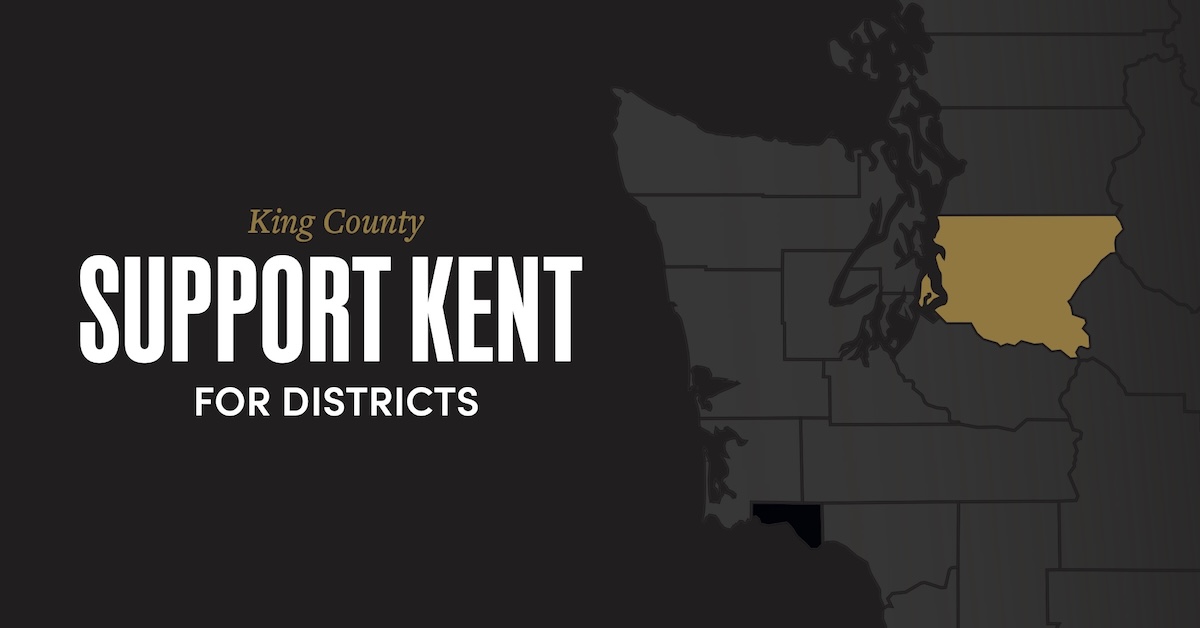
Image: Italic serif font in gold reads, “King County” with words in all caps in white underneath that say, “Support Kent for Districts” on a black background and a gold silhouette of King County on a map of Washington with surrounding counties in gray.
“I love my city,” Kent for Districts Co-Chair Mónica Mendoza-Castrejón recently told us. “It’s grown so much in my lifetime, which has only deepened the rich history and diversity of our neighborhoods. It’s a big part of what makes Kent great, but we’re missing out by not giving each of these neighborhoods a voice on our city council.”
Kent is the third-largest city in King County and ranks as one of the most diverse cities in the nation. It’s also one of the fastest growing cities in the country, due in part to skyrocketing housing prices driving people of color out of nearby Seattle. Many have found a home in Kent’s tapestry of neighborhoods—each with their own culture and sense of community.
Mónica’s love for Kent echoes our love for Washington. Like Mónica, we know that too often the people with institutional power do not always represent the people. And like Kent for Districts, a coalition that Mónica co-chairs, Inatai Foundation understands that to be a true democracy, decision makers not only need to reflect the community; they must be the community. This belief underpins much of our work, including a grant through our Campaigns, Legislation, Issues, and Policy (CLIP) Fund to Kent for Districts. The coalition is working to reshape the city’s electoral system so every neighborhood has a voice on the city council. It is currently collecting signatures to introduce a ballot measure that would make at least five of the council’s seven seats elected by voters in geographically defined districts.
The design of any electoral system profoundly influences its outcomes. The method by which votes are collected, counted, and transformed into seats directly impacts who gains political power. The City of Kent is no exception.
Kent currently uses an “at-large” system, which means all city council seats are filled by candidates who can draw the most votes from across the entire city. This model favors wealthier and less diverse neighborhoods, which have the financial resources needed to elect their neighbors and attract attention from candidates. Because of this, certain communities—especially those with fewer resources and who face greater barriers to voter turnout—tend to be vastly underrepresented. This systemic imbalance results in certain neighborhoods having more influence over elections, and elected bodies that don’t reflect the constituents they govern.
For example, the majority of Kent’s city council members live in its East Hill neighborhoods, miles removed from the smaller West Hill region nestled along Interstate 5. Despite its growing importance as a transit hub with a planned Link Light Rail station, West Hill residents frequently don’t have any council members who live in, understand, and represent their community. This lack of representation is felt across all local issues—from housing policies and zoning decisions to public safety—as the council’s focus is understandably drawn to the issues felt more acutely in their neighborhood. It’s no surprise, then, that Kent has some of the lowest voter turnout in the state with just 24 percent of registered voters submitting ballots during a recent election. Without the chance of local representation, there’s little incentive to be engaged.
As Kent for Districts has pointed out, this at-large system might have worked when Kent was a town of 40,000, but it’s insufficient for a growing city of 130,000 with a multitude of neighborhoods—each with their own contributions, views, and needs. District-based seats ensure that every neighborhood, including those historically underrepresented, has a council member elected by and accountable to their local community.
As a 501(c)(4) funder, Inatai supports leaders and organizations that unapologetically defend their communities, dismantle exclusionary power structures, and work to build equitable systems. By supporting Kent for Districts, we are endorsing a vision of democracy where every person has a say in the decisions that shape their lives. We believe that smaller, district-based elections will enable candidates from each neighborhood to engage more deeply with constituents, fostering greater community organizing power and stronger voter involvement. We are honored to support and follow coalitions like Kent for Districts in calling for an inclusive and participatory democracy.
To learn more about Kent for Districts and how you can support their work to strengthen democracy, please visit www.kentfordistricts.com.



